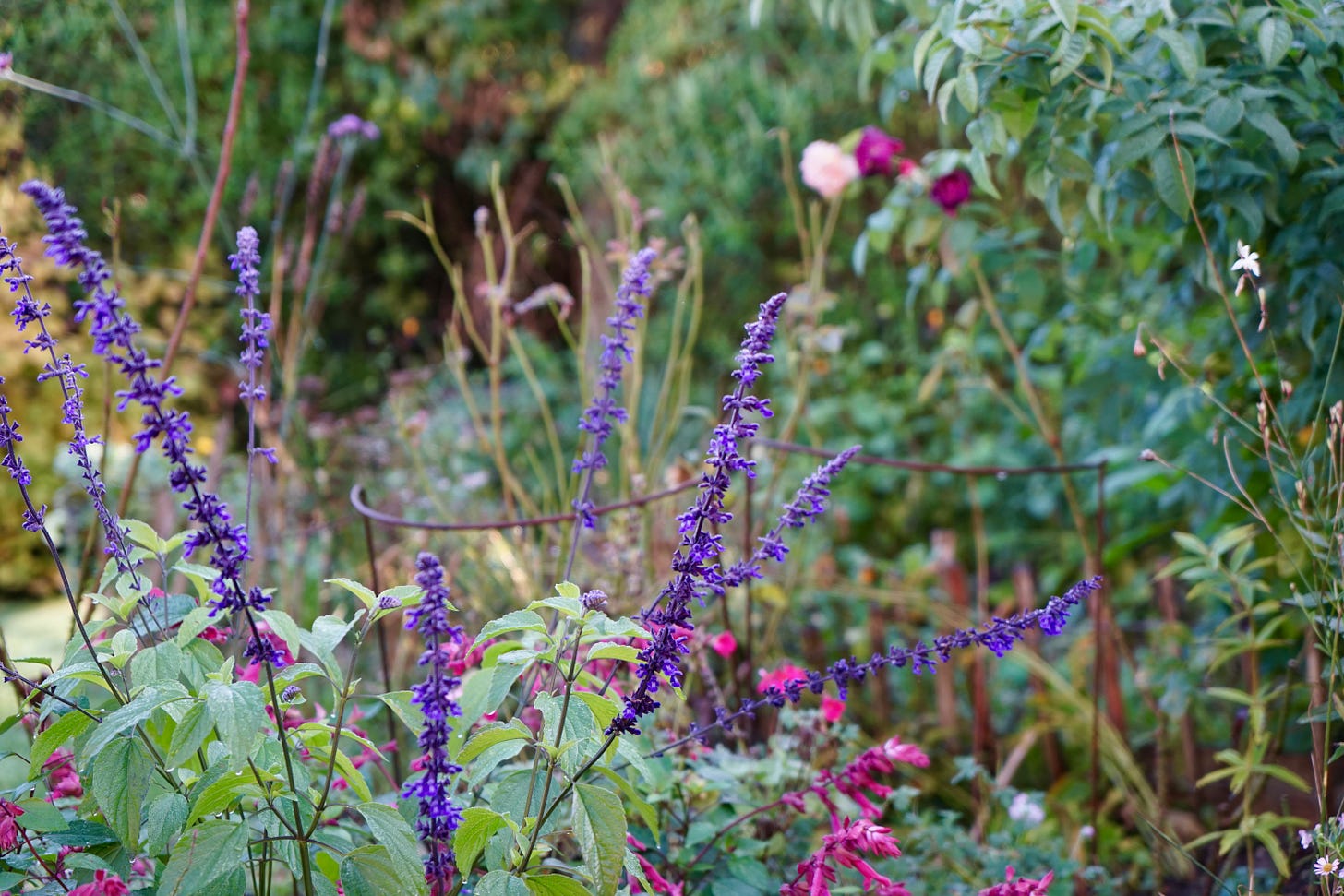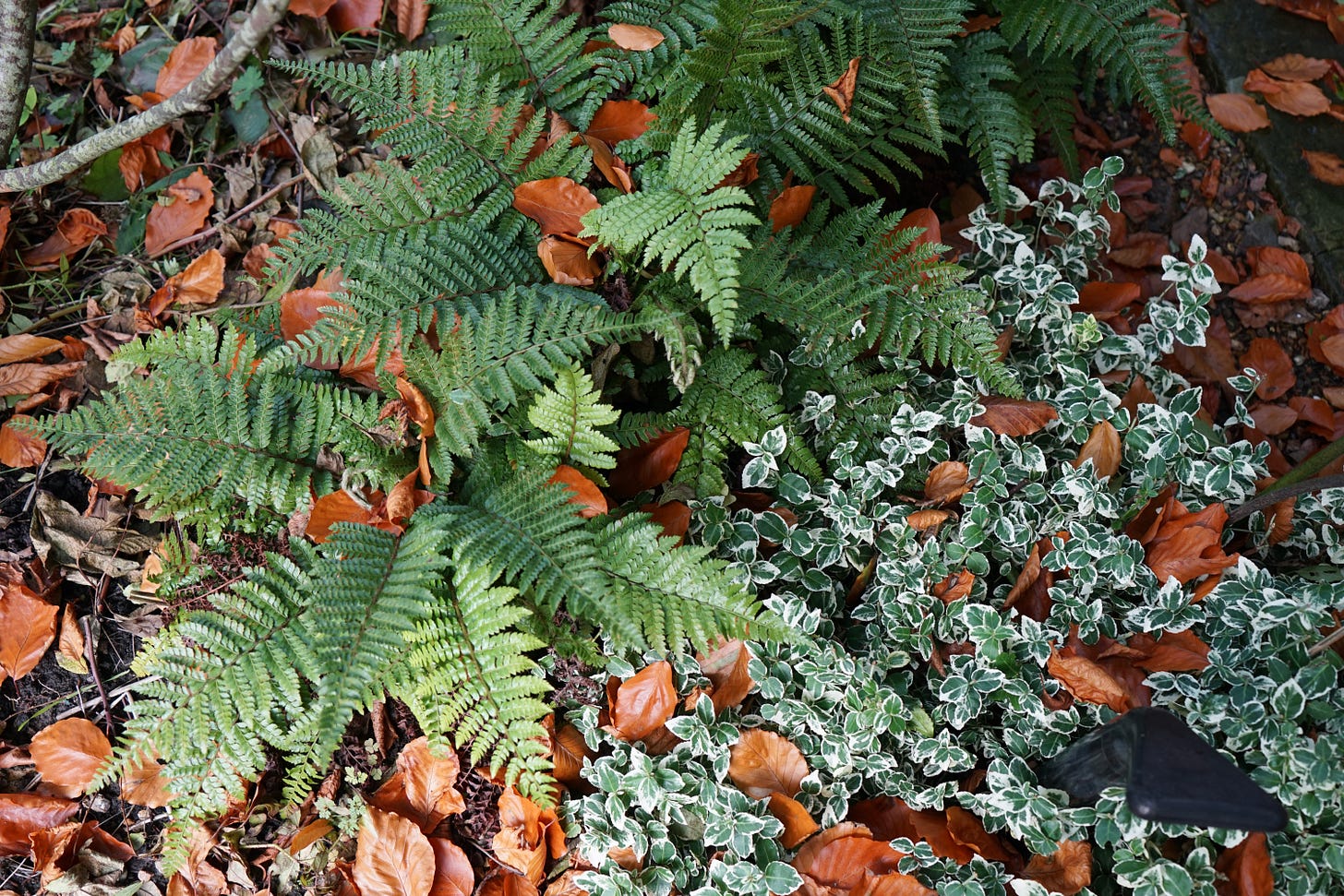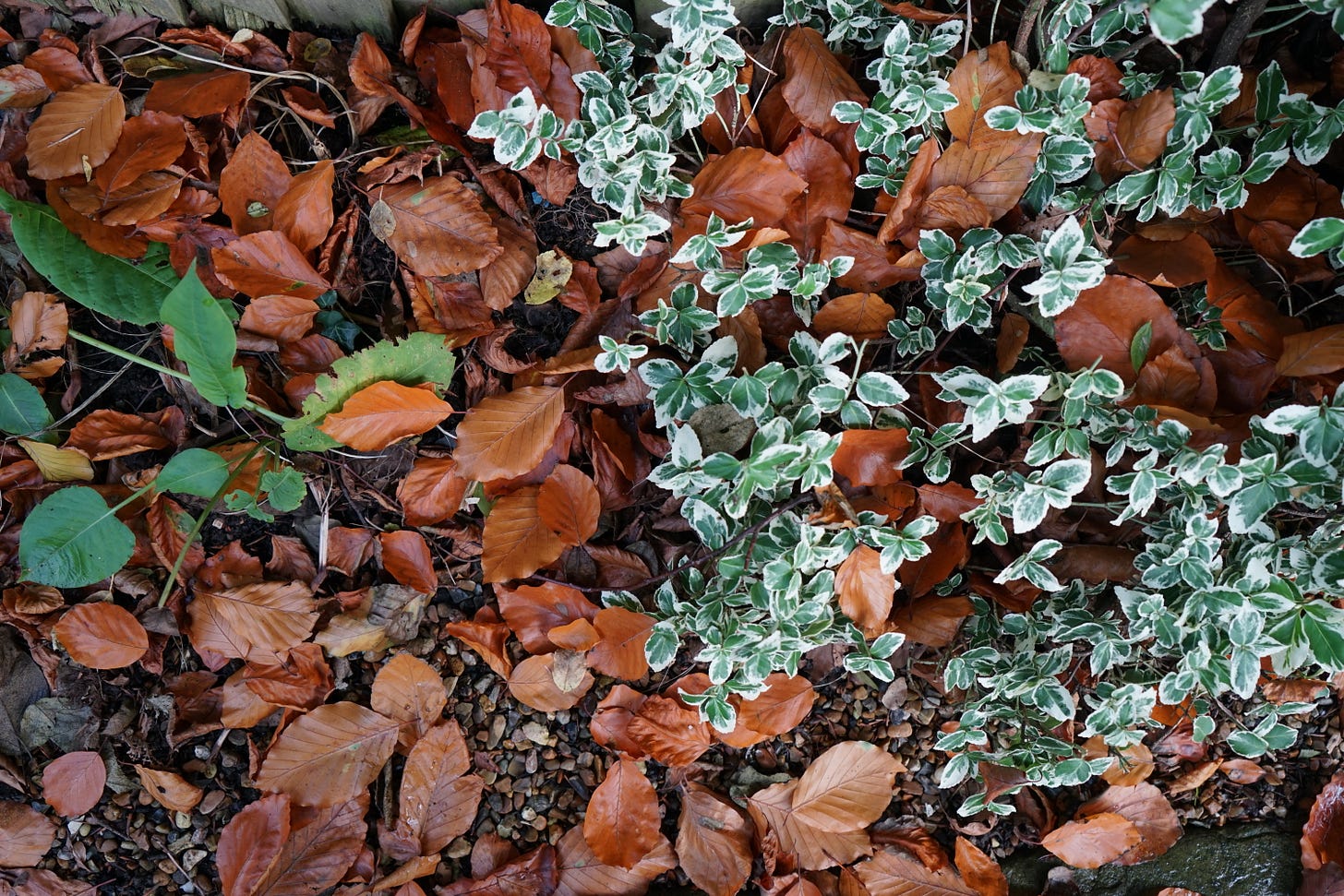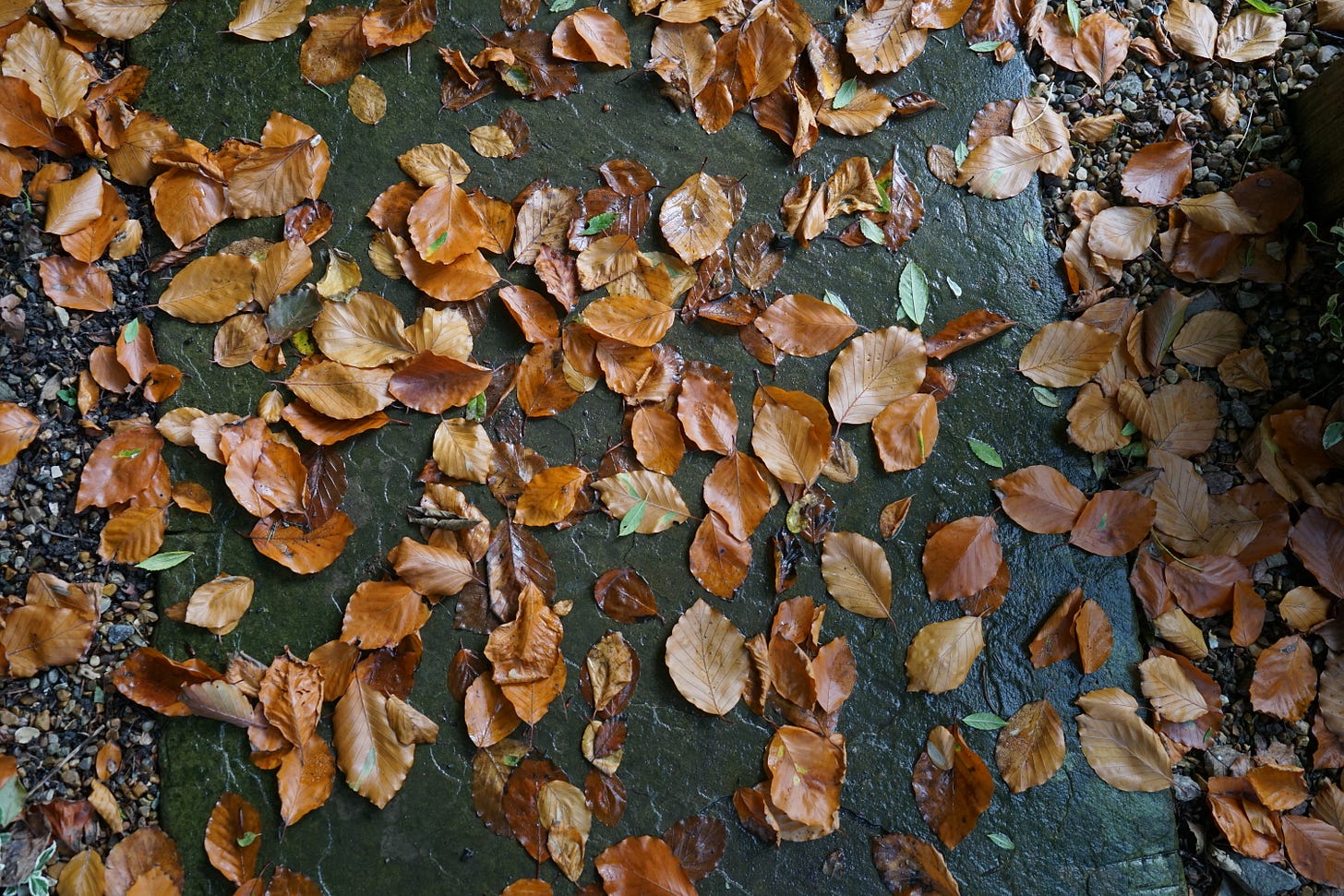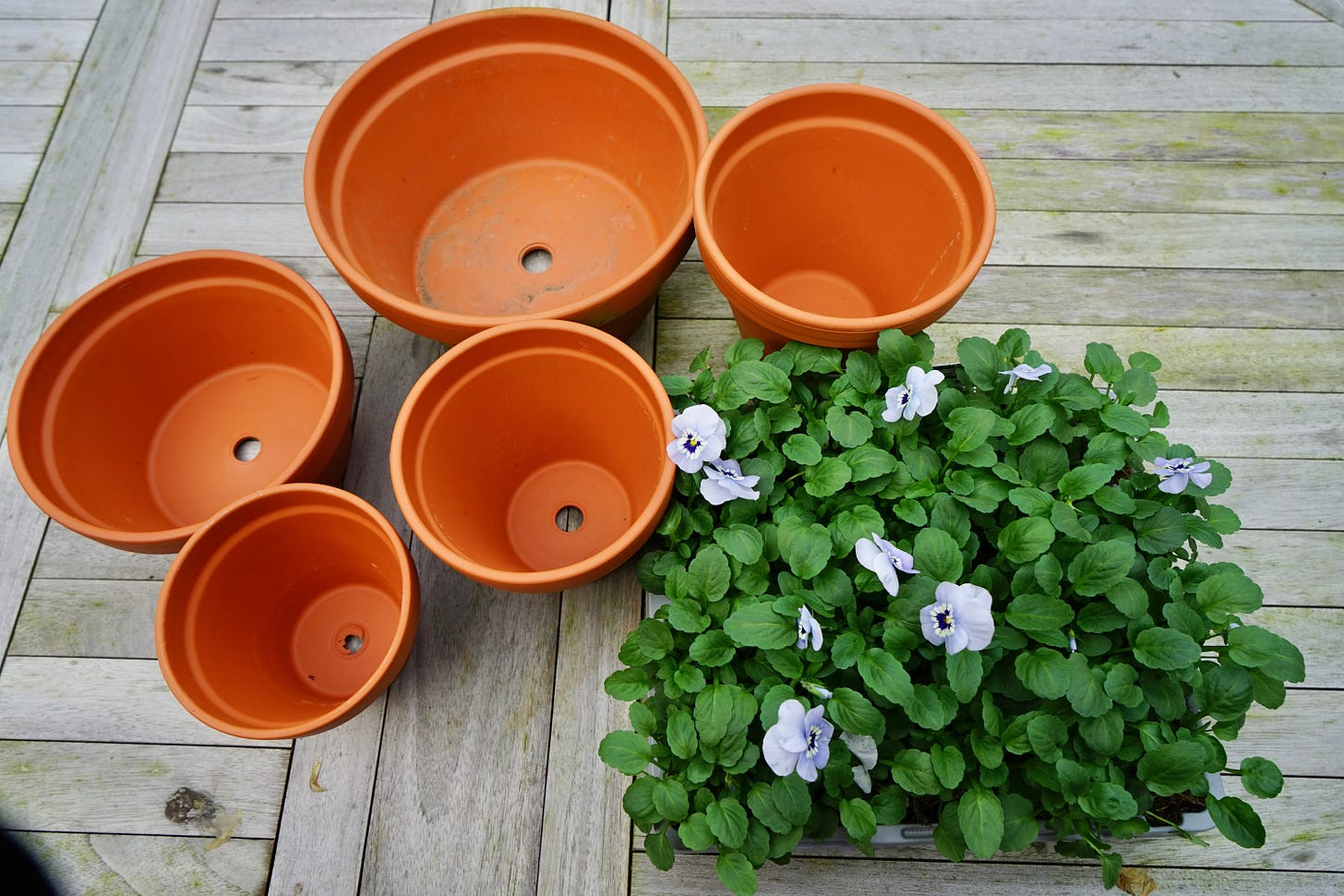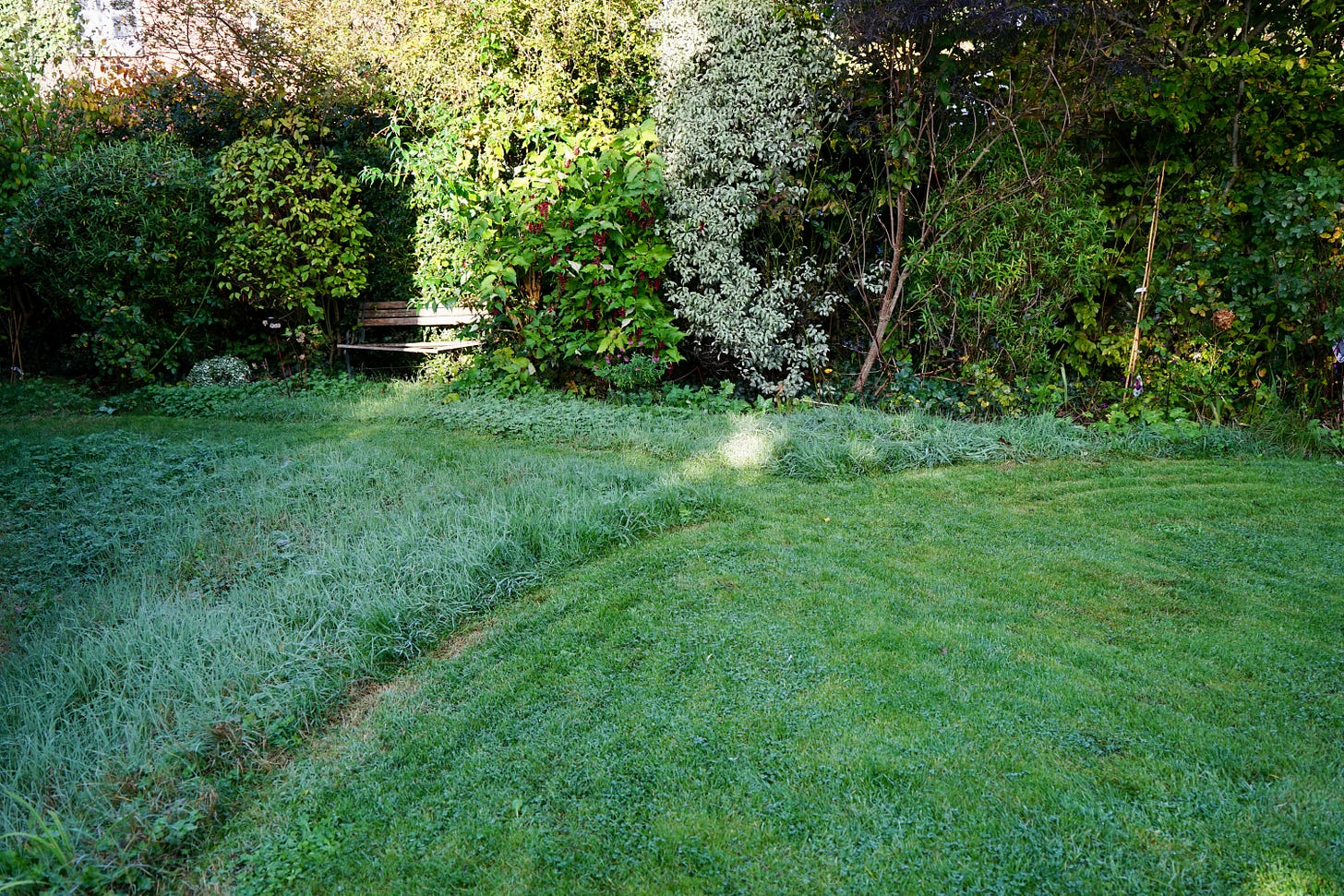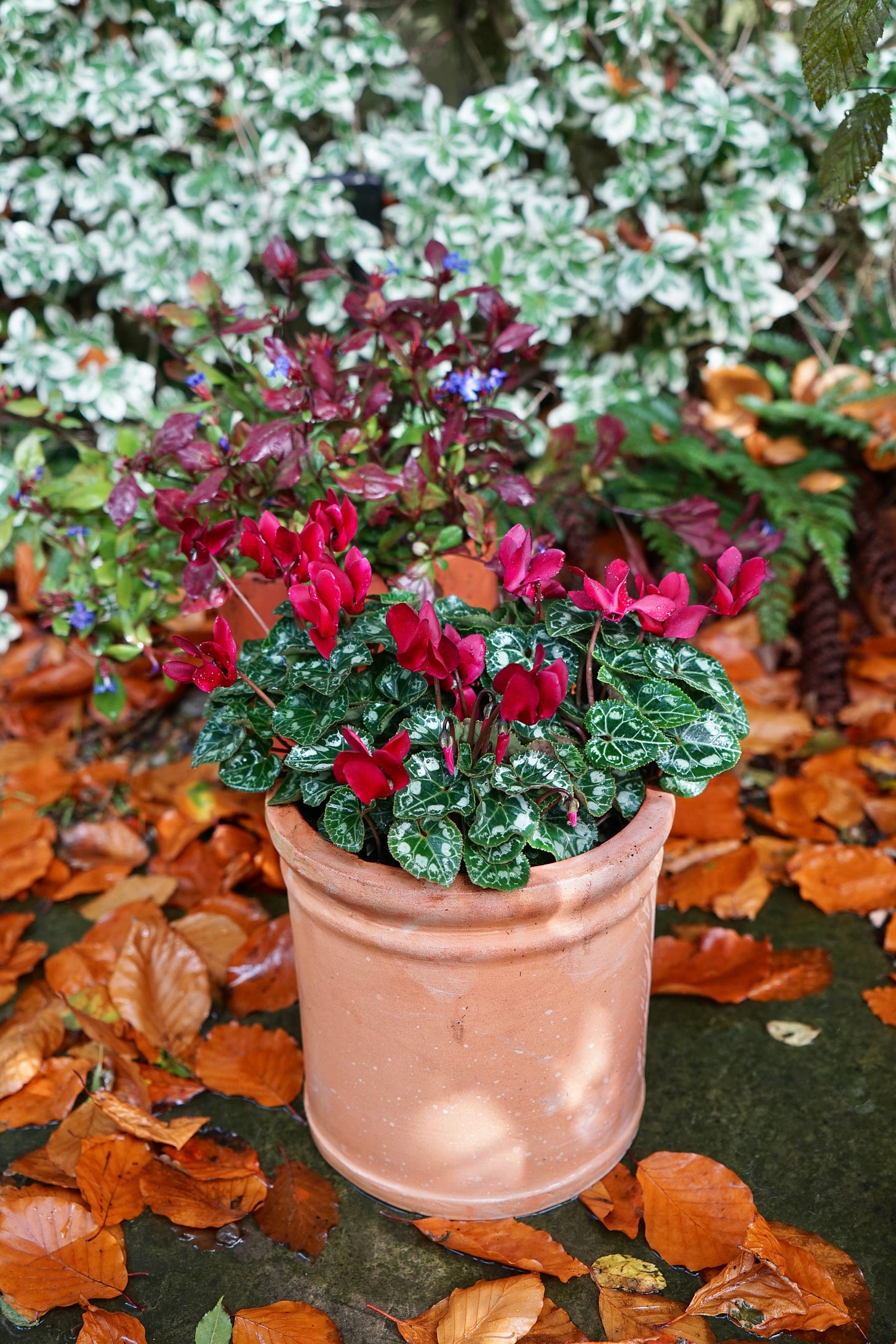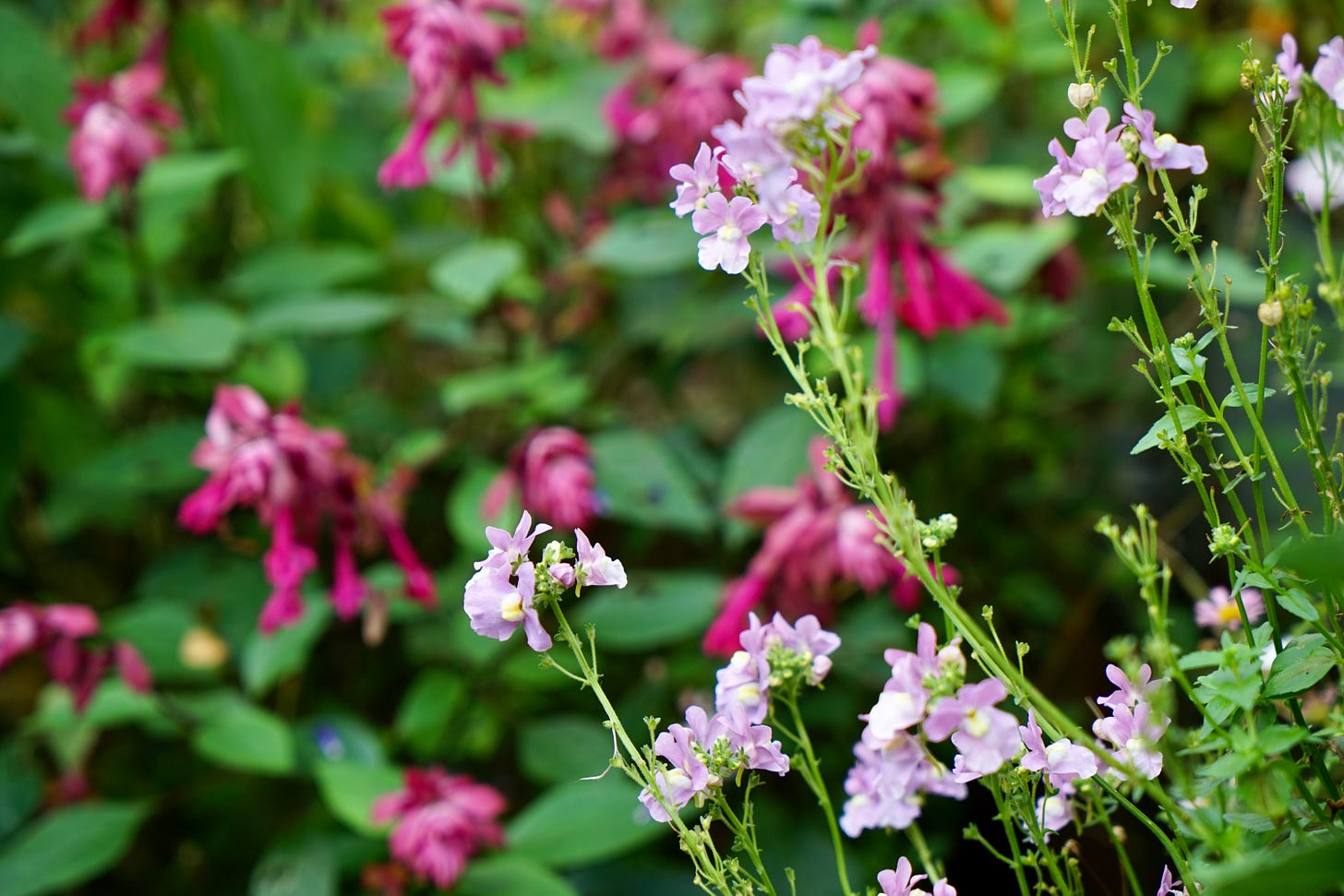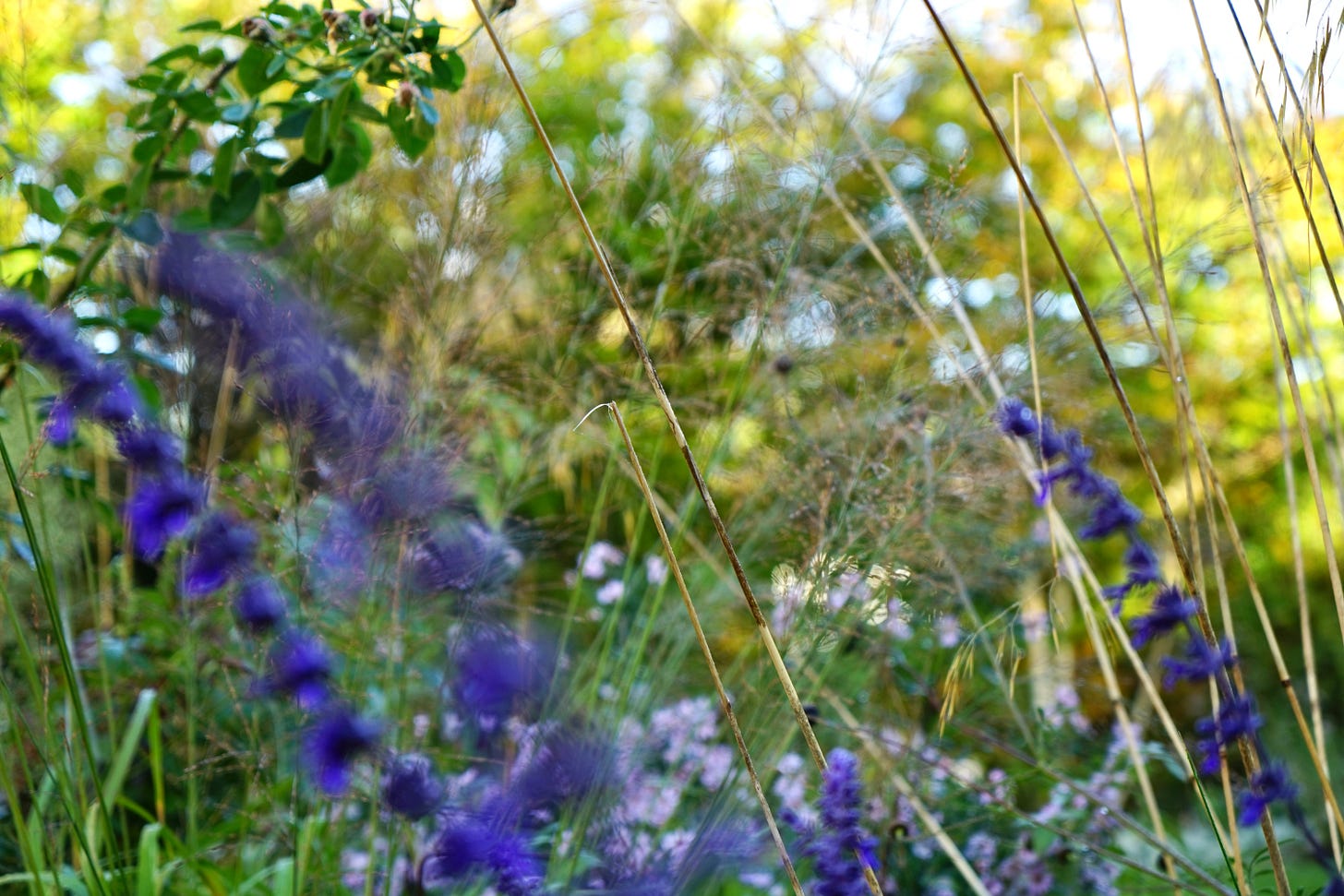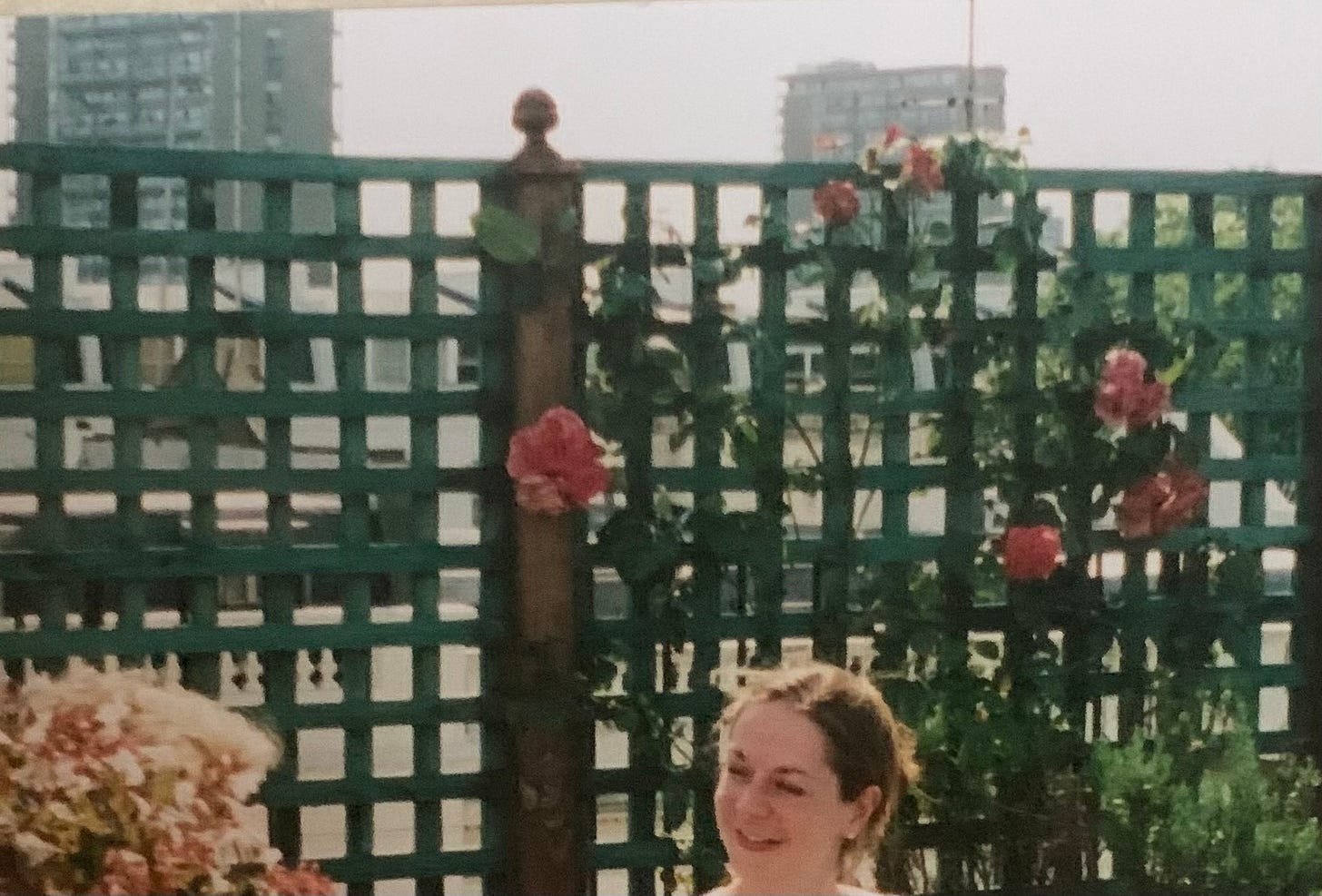The Small Garden Design Course
Plus: October's container planting idea, squirrels, why you shouldn't sweep up autumn leaves, best asters, and lots of news
As it has lots of images, this post may be too long for email so please do have a look at it on your laptop/desktop instead.
I’m going to be introducing you to the Small Garden Design course: don’t worry, you don’t have to do ANYTHING. Just be up for joining us on the ride
Hello, and if you’re lucky, you may even have had a bit of sunshine in the last few days. But whether you have or not, you’ve landed in exactly the right place:
Autumn flowers, happy pollinators, and a bit of garden design: it’s all here for you in this week’s episode of The Gardening Mind. It is another bumper edition, for you to pick and choose from, with loads to keep you going, whatever level of gardener you are:
I’m going to be introducing you to the Small Garden Design course: don’t worry, you don’t have to do ANYTHING. Just be up for joining us on the ride.
There’s the easiest of October containers for you.
I’ve put together all the asters you recommended - there are some beauties.
We need to have a word about squirrels.
Have you signed up to The Gardening Mind yet? Free subscribers will be able to preview the first few items here, and paid subscribers will be able to see the full article every week, including: the to-do list, solutions to your gardening challenges, the small garden design course, planting ideas, gardeners’ question times, and more. Paid subscribers will also have exclusive access to the weekly Show Us Your Plots which is our regular get-together on the Chat, where we share ideas and solve problems throughout the week. A subscription works out at £1.30 per week if you sign up for the yearly plan - see it as a garden investment, as you’ll have loads of ideas by the end of each read. Plus, prices are going up soon so if you subscribe now, you’ll get the same annual price for a lifetime.
The next instalment will be in your inbox on Tuesday
Before we get onto all of that, welcome to subscribers old and new - I want to give you a great big welcome into the Gardening Mind fold.
As you’ll soon discover, it’s a super-friendly place, and whether you like to quietly observe or join in with the Chats and courses, I think you’ll have found your people. That’s what it feels like to me. If you’re feeling that, come and join to get the full experience of this gorgeous (you really are) online gardening community:
Before we get going, please could you hit the ❤️ button? It ensures that this article appears to people who otherwise wouldn’t see it. Thank you ❤️
There is A LOT OF NEWS this week.
Keep a look-out for Tuesday 22nd’s very exciting news which will be arriving here on Substack around lunchtime - let’s just say it’ll be a Substack first. I’ll be following it up by going live with more information about The News here on Substack on the same day at 7pm UK time. If you haven’t yet got the app, you can get it here:
I regularly host Zooms for paid subscribers. The next one, in which I’ll be introducing the Small Garden Design Course, takes place tomorrow Sunday 20th October at 6.30pm UK time - the invitation is at the bottom of this email.
Please do feel free to come and join us for 45 minutes of chatting about the small garden design course (there’s more about the first week of this course later in this post) and what you’ll need for it (not much). I’ll be recording this zoom, but it would be really, really lovely if you could make it. You don’t have to chat if you don’t want to - you don’t even have to have your cameras on!
There’s some more exciting news: The Gardening Mind has been short-listed for the Garden Media Guild’s Digital Gardening Writer of the Year award, along with some lovely familiar Substack faces:
, and . I am SO CHUFFED for Substack - it’s definitely the place to be for online garden writing. A great big enormous and massive THANK YOU to you, for being here to support the writers.Lots of you have asked for a link to the recent posts about bulbs: you can find some of them here:
Bulb meadows and how to make them
Daffodils, iris reticulata and other small spring bulbs
You may also like:
Daffodils from February till May
Over on the Chat, have a look for the Midweek Mooch where you can post video updates of your garden. The Chat has become a huge part of this gardening community - if you’re a paid subscriber you can start conversations, ask gardening questions, and post photos. It’s taken on a life of its own, so do use it!
On the regular Sunday Show Us Your Plots on the Chat, you can show us what your garden, or any green space near you, is looking like - we’d love to see - and we’re not judgemental! All-comers from everywhere are welcome and we have members from all over the world. This Chat goes bananas so do come and join in the fun!
This week, it’s the start of the brand new Small Garden Design Course
I experienced the satisfaction of creating something from nearly-nothing. I got the adrenaline rush of seeing the potential. And even now, none of these emotions ever leave me when I’m looking at the most unprepossessing of outdoor spaces. And that’s what and how I want you to feel too.
But, before we get to that, I posted this note earlier this week and I’d love to hear your opinion:
Are you able to get out into your garden, or is it water-logged? And if you can get out there, are you raking up leaves? I for one, will not be doing so:
It’s certainly been windy and rainy all over Northern Europe, and I have huge drifts of leaves all over the place, as, in the face of the weather, the copper beech which looms over my garden decided not to put up a battle and instead has started to drop a lot of its leaves in a gusty flash. I know some will be getting their rakes out, but I’ll be leaving these leaves on my borders, as I’ve pretty much always done.
This is partly out of laziness, I admit. But this habit stems out of an inability to understand how fallen leaves don’t affect the countryside around our tended gardens, and so why should I then need to clear them from the soil in my flowerbeds? These leaves cover and then degrade. Plants grow from beneath. The cycle continues.
The idea of sweeping up leaves must mainly stem from an idea of tidiness, and maybe hygiene and ‘letting your soil breathe’ whatever that means. But, and I admit this is mainly out of a slight idleness, I’ve never cleared my leaves from beds, apart from where I brush them aside to plant bulbs in November through to February.
But even then, I sometimes scrabble the leaves back over where I’ve dug, in a super-casual way, as part one of my five-layered squirrel defence.However clever your resident squirrel may be, to him or her, newly-disturbed ground represents a massive clue, and so it logically follows that the less disturbed the soil looks, the bigger the chance that the squirrel won’t head for it the second you walk away. It’s not completely foolproof, I hasten to underline, but it’s just one of the many layers I employ to outwit these pesky little things. (Or not so little - I’ve seen some monster squirrels in London, fat and contented after dining on the neighbourhood’s autumn plantings).
In answer to a couple of comments regarding optimum planting time on the recent thread on bulb-buying, here’s an extract from this previous post on bulbs, in which I touch once more on the touchy issue of THE SQUIRREL.

If you can bank on squirrels in your garden, don’t bank on tulips there.
I’d love to hear any successful methods you use to deter this pesky whirlwind of fur. My friend Jo Fairley swears by a layer of seaweed over pots, whilst I think a layer of chicken wire over any planting, with a thin layer of soil on top, does the trick. Jo also firmly believes that squirrels can put two and two together very quickly and so are attracted by newly-disturbed ground, therefore if you add a layer of leaves and make the spot look all forest-floory, they’re more likely to leave it alone.
Based both on the principle that it doesn’t seem to do the bluebells any harm in the woods, and also on the fact that gathering all the leaves and storing them in bags in the shed for them to rot down and make leaf-mould, which then needs to be taken back out into the garden and replaced in the same spot where I gathered the original leaves from in the first place, leaf-removal has always struck me as a step too far and also something of a busy-making exercise.
Yes, pick them up from your lawns, and yes, of course remove them from paving as wet leaves will just make you slip otherwise, and yes, do put all these that you do pick up into bags and then into your shed to then place on your beds later. But moving them from beds (unless you’ve got some very tiny bulbs in there)? No. Think forest floor.
I won’t be raking up too many leaves, and all the tulips I buy are going into pots, which will have chicken wire over them, followed by compost and leaves.
I don’t worry too much about the pots - I pick up cheap terracotta ones from the local garden centre. They look quite shinily orange right now, but give them a rainy winter and they’ll be fine. The violas form part of the squirrel defences: I’m buying packs of them so that when it comes to putting the tulips in pots, I’ll pop a few on top each pot as an extra deterrent - as well as prettiness - through the winter.
Life doesn’t need to be complicated, and if we can make gardening work for us and be one of the simple things, then let’s not overlook the easy wins.
Regarding the bulb meadow cheat sheet in this post, you may be wondering how I can have a meadow in my village garden. The answer is that I don’t have one. Essentially, this is it:
Over the last ten years, I’ve been letting this interconnecting area of lawn grow, only cutting it twice a year, with a path mown through. It’s amazing to see what species are coming up in it, and it’s just had a mow while the sun was out. The bulbs will go in those two patches of longer grass, which were last cut over three months ago.
You don’t have to have an enormous space to achieve an effect - what do you think? Have you got an area where you might be able to give this a go? The wildlife will definitely thank you.
This month’s container is possibly the simplest you’ll see here - life doesn’t need to be complicated, and if we can make gardening work for us and be one of the simple things, then let’s not overlook the easy wins.
Cyclamen are one such easy win. You can buy them as corms in the spring, but here’s a thing: I can’t resist their jewel colours when they start appearing in the nurseries round about now, so I buy a few of them in small pots and pop them in a simple container. It’s as easy as it sounds, practically effortless, and yet so effective. I’m a big fan of the ratio of effort:effect here.
Pretty under trees in pale shades of pink to white, I’m rather partial to the vibrant reds and scarlets, with colours so deep as to almost appear velvety.
Just behind it you might just be able to spot the purple foliage and the brightest of blues of Ceratostigma plumbaginoides, a great plant for autumn colour, which works well in a pot as a kind of background fluff behind other pots. Just look at those deeper-than-forget-me-not blue blues and leaves which turn purple as they age:
The label on this little cyclamen beauty said it’s called Mini Wine, but if you nip to your local supplier, you’re bound to find something that fits the bill. Sticking with one colour in a pot, I have great fun moving this one around. Sometimes it sits in the dappled shade of a tree; sometimes it gets moved to a sunnier spot:
While we’re playing around, just look at the surrounding planted containers which I first wrote about here, which are still going strong five months after being planted.
There are few plants in particular which have been magnificent, and have needed basically no extra watering. I know we’ve had a rainy summer, nevertheless they are brilliant performers. I expected the blue salvia to fizzle out by the end of September at the very latest, but no, it’s still going strong.
Nemesia ‘Melody Pink’ is hardier than other varieties. A cottage garden favourite, it flowers from March to October, it smells great, and again, the pollinator’s love it.
Salvia ‘Wendy’s Wishes’ bears masses of ruby-magenta flowers all the way from June to September in theory, but is simply loving October. It has dramatic deep dark red stems which add a bit of drama to the whole thing.
Salvia ‘Indigo Spires’ is a floppy perennial with spikes of deep sapphire blue flowers till, I thought, the end of August. But it’s still flowering happily in this pot and I imagine it probably will carry on doing so until the next big frost. It is NOT hardy, so you have to either dig it up and bring it in, or want it so badly that you’ll put up with only having it for one year.
By the way, you know when I talk about ‘veil planting’ and plants with naked stems - just have a look at these layers below.
There’s the salvia, all blurry blue, with the veil of molinia behind, and the pale dots of asters (see below) just visible behind that. None of these plants block out the light but they create a gentle notion of a boundary - the perfect way to define a space. We’ll be discussing this aspect so much more in the Small Garden Design course…
Which brings me neatly on to:
Welcome!
This course is relevant for any sized garden. You may have a tiny garden, or you may have a smaller space that needs dealing with in a bigger garden. Small garden spaces are very dear to my heart: it’s how I started off in garden design nearly 30 years ago, creating the tiniest and therefore trickiest of gardens, and this continues to be something I love to do. So when a prospective client calls and describes their “impossible dank and shady courtyard which we’re desperate to turn into an outdoor room; we’d love you to help us but maybe you don’t design small gardens”, you can guess what my answer is:
“Size doesn’t matter”.
The size of your outside space doesn’t matter. You have it, you can do something with it and it’ll make your life better. It really will.
How I first became a garden designer:
(If you’ve been part of The Gardening Mind for a while, you’ll know this story, so please forgive the repetition and skip this bit!)
After studying modern languages with a hefty dose of history of art, I’d toyed with working in fashion (there’s a story for another time), PR (and another), academia (and you can imagine that story!), followed by a stint in teaching. But it was only when I moved to a tiny flat in London, which had no outside space apart from a flat roof accessed from a door in the ceiling below, that this whole new world of creating gardens opened up to me.
I KNEW this space up on my city rooftop offered potential. The precarious ‘altana’ roof terrace constructions of Venice that I’d spotted during a year studying in Italy gave me an absolute belief that if these ancient structures, which do amazingly stay up, work, then I could do something a lot less complicated with what I had in London.
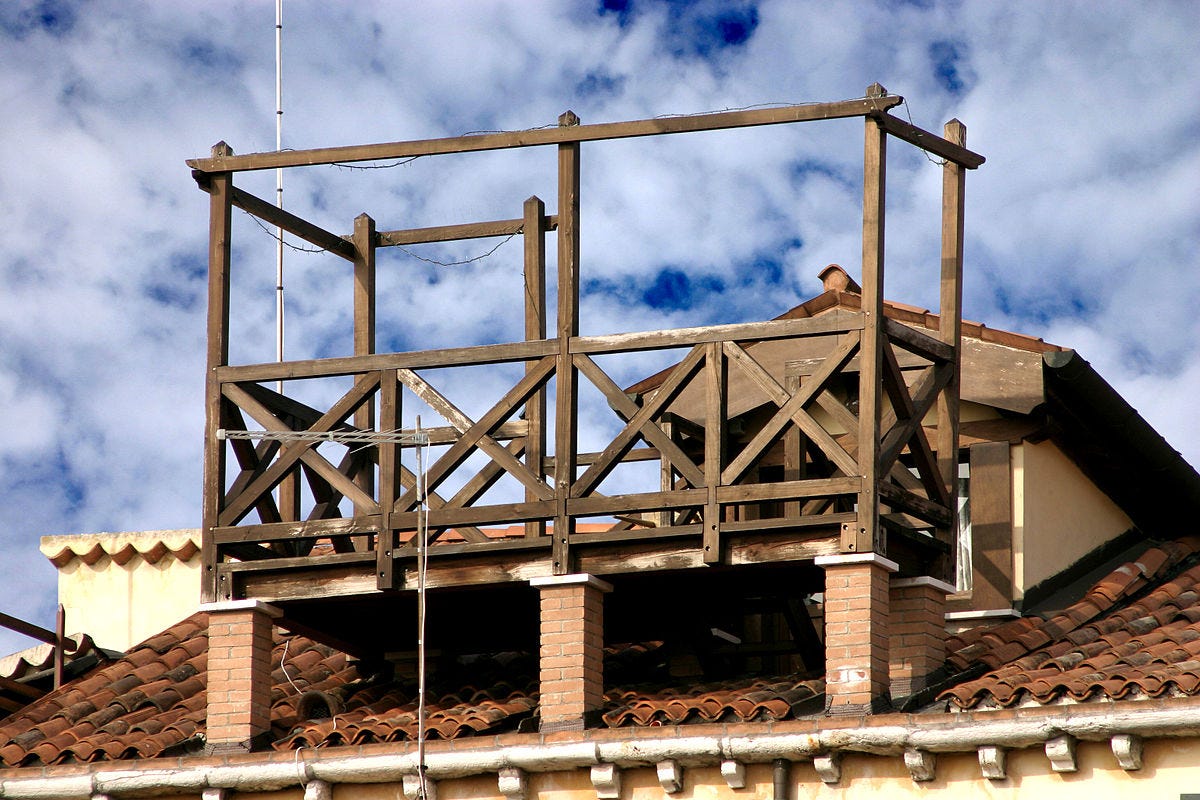
I did thank my lucky stars that instead of this mind-blowingly practical-yet-terrifying solution, which is, I kid you not, still built and used in Venice today, here in London I already had a flat space available. I wouldn’t have to build a kind of shelf on wobbly stilts. However, I still knew that before doing anything on this roof, whatever that ‘anything’ might turn out to be, I would very definitely need to think about those minor matters such as stopping people falling off the roof to the pavement five floors below, whilst also ensuring that the whole garden wouldn’t one day make a sudden unannounced and unwelcome appearance in my bedroom below. I called upon the assistance of a nearby garden centre; they sent over a designer and that was that. I took myself back to college, and undertook the most comprehensive course in garden design that I could find at the time.
So what had happened to make me take that big move into the unknown world of gardens?
There had been a lightbulb moment when the designer talked to me about structural engineers, trellis heights, low maintenance and lightweight fibreglass plant pots. I realised that garden design was an actual thing. I can’t even begin to describe my elation at having an actual space outside, up amongst the chimney pots of Maida Vale. And I had a realisation, as I looked along the now-visible neighbouring rooftops, that there was a whole other life going on up here, with flowerpots and tables and sunloungers scattered down this street in the sky. I experienced the satisfaction of creating something from nearly-nothing. I got the adrenaline rush of seeing the potential. And even now, none of these emotions ever leave me when I’m looking at the most unprepossessing of outdoor spaces. And that’s what and how I want you to feel too.
My photographic documenting back in the day was pretty haphazard, but I’ve managed to dig out this blurred and strangely-arranged snap. There I was, safe and not falling off the terrace, within a framework of green-stained trellis, which on reflection, I’d now probably ask for in a more natural finish to match the wooden uprights. I loved the gorgeous finials (I hadn’t a clue what a finial was, but as soon as I saw it I realised the ‘finishing-off’ that this tiny architectural detailed knob brought with it), and I adored my first ever rose that I ever grew, Rosa ‘Pink Perpétue, which was as happy as anything up there in its first season. This rose, by the way, is great for a roof terrace, as well as for shady spots, and it will even tolerate a bit of facing north. And it’s fragrant.
This solution of trellis + lightweight pots + easy plants was so simple. It was a solution that made me happy, creating a space outside, out in the air and under skies which changed the view every day.
Now, I know I was lucky to have access to that space. It may not seem small in comparison to the space you have in mind, or it may indeed be much smaller than your space. Size is relative: if you think you have a small garden, then do come along with me as I start to examine the process.
Now it’s your turn - what will the course require from you?
This is SO simple. You’ll just need the following:
A space you’d like to use as your subject
A dedicated notebook - yay, a chance to use that notebook! And/or an A4 ringbinder to keep your loose sheets in
Some tracing paper, pens and pencils. Any tracing paper is fine.
A scale rule possibly - but not essential
Some sort of cheap masking tape can come in handy when you’re using tracing paper
That’s it.
The following may seem obvious, but the very first thing I’m going to ask you to do is to identify a space that you’d like to tackle. That’s if, of course, you’d like to engage in the process - you may instead simply be an interested observer - all-comers are welcome!
And remember, it doesn’t need to be your whole garden. It might be just a corner that you’re looking at. It’s all relative. Have a think.
I’m going to be looking at three different case studies during this course, to show you as many ideas as possible:
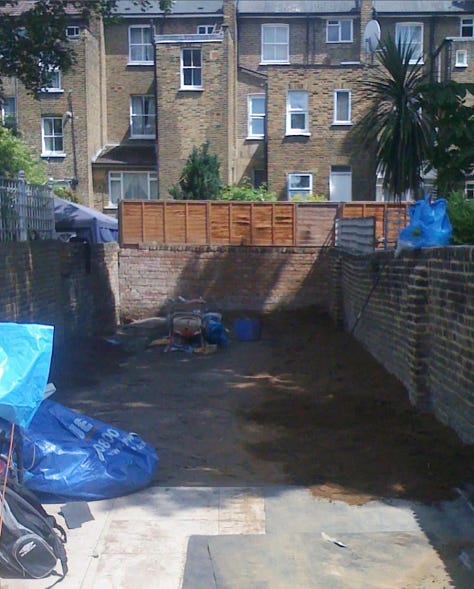

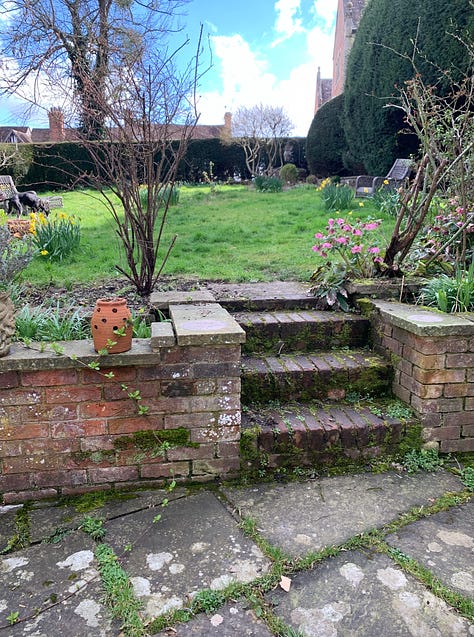
I firmly believe that every single space has potential, and I want you to be able to have the luxury of enjoying an outside space, as well as having the satisfaction of creating a garden for both you and for the wildlife that I guarantee will arrive as soon as you plant a plant.
I cannot wait to see what space you choose to work with.
You’re probably wondering what we’ll be looking at in this course, and how far we’ll go. Don’t panic about it being overwhelming - we’ve got the comments here where we can toss ideas around, as well as dedicated Chat sessions, and there’ll also be the opportunity for one-to-one meetings to go over your hopes, thoughts and designs.
One of the key things I’ll be sharing with you is my philosophy and approach to gardens, the ideas which flow through every garden I work with. Gardens should withstand the test of time. They shouldn’t be instantly recognisable as a garden that I, Jo Thompson, have designed. I want it to be all about the garden, the client, the location. I don’t want it all to be about me. Remember those words - they’re important.
We’ll be looking at the importance of garden functionality and aesthetics: gardens need to be beautiful, yes, and they need to feel right for the space. We need to get the framework right, as well as the way we move around the garden, and even these routes can be things of beauty in themselves.
However small or impossible your garden feels, this course really will help you to take a new look at it, and I’m hoping you’ll feel brave enough to start implementing some of your ideas:
I hope this has inspired you - I promise you, it is possible, and by the end of this course, you’ll have ideas for your garden. In the Zoom, I’ll be sharing the whole course outline.



